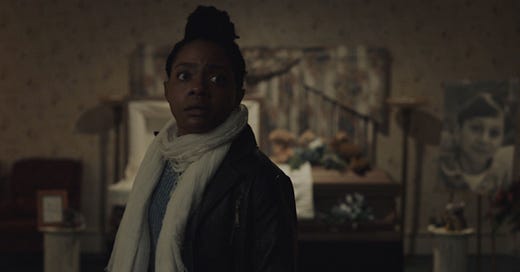Review: The Harbinger (2022)
A pandemic film that reminds us of the fear we'd rather soon forget.
We are now at the point where we are getting pandemic movies (not movies shot and filmed during the pandemic, we’ve had those since before you understood the 19 in COVID-19), but pandemic movies - those that take place during the height of lockdown and use it as a narrative device.
And that was, as you most definitely know as well as I, an extremely scary time. Fear for health. Misinformation. A complete disposal of everything you thought you knew about daily life.
It was only a matter of time before horror filmmakers capitalized on those fears, ignored the “Too soon?” question, and served up a single-shot dose of the real-life things that scare us more than any horror film could.
Writer/director/editor Andy Mitton’s (The Witch in the Window, YellowBrickRoad) latest feature, The Harbinger (not to be confused with the film of the same title from earlier this year), hits select theaters and video on demand today with all that and more in a film that brings your nightmares into reality - pun intended.
Monique (Gabby Beans) is strictly and safely quarantining with her brother and father when her phone rings - a call from a distant friend, Mavis (Ellen Davis), who can no longer sleep. Her nightmares are seeping into her everyday life. Alone in her NYC apartment, she’s seeing things, having hysteric episodes, and even committing acts of self-harm in her sleepwalking state. With no one else to turn to, she requests Mo’s help, calling in a debt-of-gratitude favor. Despite their misgivings, Monique leaves her family’s bubble and ventures out to help her old friend.
When she arrives, she sees that it’s as bad as it sounds. She begins to see the visions too, her insomnia blurring the lines of reality. Their consultation (over Zoom) with a demonologist suggests that they aren’t crazy. Instead, they’re being preyed upon by the titular Harbinger, who will continue to feast on their insanity until they’re “hollowed out.” The demonologist is too freaked herself to continue explaining, rushes off the call (maybe her complimentary 40 minutes were coming to a close?), and leaves the women with a hell of a lot more questions than answers.
Those questions (What is this thing? What does it want? Why us? Why now?) will be answered throughout the film with visualized hallucinations to keep you lured in. The spookiest of those visuals is, of course, The Harbinger, who resembles a 16th or 17th-century plague doctor, those recalled enough times in 2020’s March 20-somethings to give you your own nightmares. Those indicators of death are synonymous with the death and turmoil of plagues and evoking that image is a shortcut to the heebee jeebee feelings that we would rather soon forget.
The Harbinger, the film not the creature, uses plenty of those shortcuts to be effective. Dreams bleeding into reality is the basic premise of one of the most successful slasher franchises. Pale little boys whispering cryptic fortunes in your ear are an oft-used horror storytelling beat. An endless snowscape is the most punishing of settings. However, it’s how these familiar beats are used that make The Harbinger effective.
Horror films are rarely scary - that is, deeper than spine-chilling or hair-raising, but deeply psychologically unsettling. The film is just that, using those tropes to distract from the real-life terrors at hand. The film can never rest as it’s either the most insane of dream sequences or the more truthful real-life matters. Sticking the landing between those two can be a tricky feat for the film’s ending to pull off. Some will find it indecisive while others will see the film’s deeper messages as the core of the story’s truth, but all must watch to decide for themselves.






